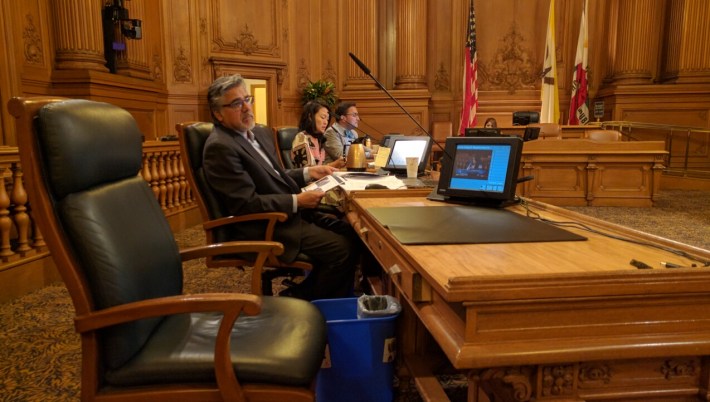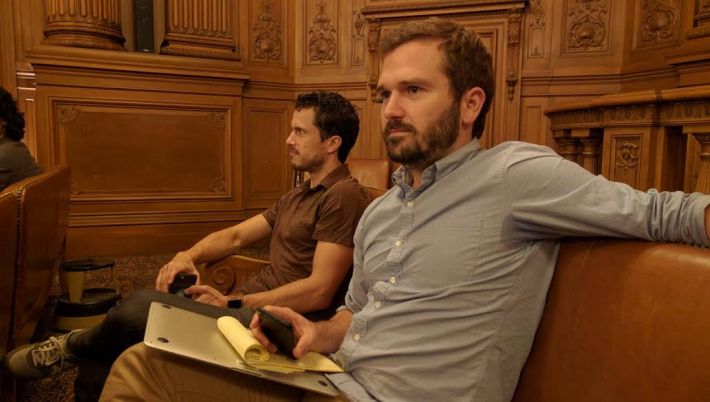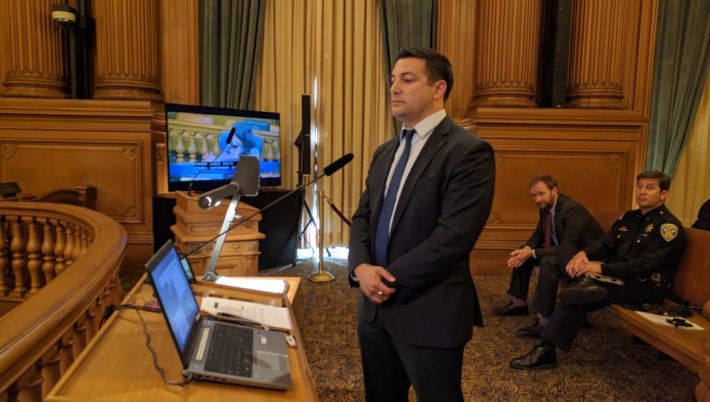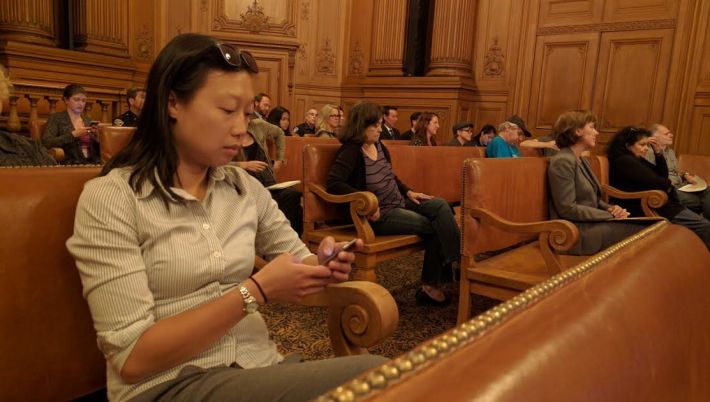Push Continues in City Hall for Safer Bike Infrastructure
5:38 PM PDT on September 9, 2016

Note the 'call to action' at the end of this post.
Yesterday afternoon, some 30 officials, police officers, advocates, and other members of the public joined the regular meeting of the Public Safety and Neighborhood Services Committee of the San Francisco Board of Supervisors at City Hall to discuss how to get protected bike lanes installed quickly on San Francisco's most dangerous streets.
"It is incredibly frustrating to our city and residents to continue to see people killed and injured on our streets," said District 6 Supervisor Jane Kim, "Are we working with the urgency that we need to take?"
The people killed whom Kim was referring to were, of course, Kate Slattery and Heather Miller. They died while riding their bikes in San Francisco on the evening of June 22. Over a month later, Mayor Ed Lee issued an Executive Directive instructing "SFMTA to deliver near-term safety improvements on 7th and 8th Streets in the next nine months" and the SF Recreation & Parks Department "to deliver near-term safety improvements to reduce speeds and vehicular through-traffic on JFK Drive in the next six months," among other things. The hearing was part of an ongoing effort to check up on and make sure agencies followed through.
"It’s not just engineering. And it’s not just enforcement. It's those two plus education," explained Tom McGuire, Director of Sustainable Streets for SFMTA. "We believe you should be able to ride safely if you’re 80 or eight or anywhere in between. Kate Slattery and Heather Miller remind us we’re not there."
Indeed, San Francisco is not there, but the question Kim and other members of the panel and public demanded to know is, "Why not?"

"I emailed the city in October of last year that we need protected bike lanes," explained Patrick Traughber, a San Francisco cyclist who came to the hearing. "Kate Slattery is dead. Now they are saying it will take another year?" Jay Harris, who cycles daily, also came to observe the meeting. "I want to hear what's being said and how people who make decisions are responding."

And what was being said--repeatedly--is that San Francisco needs protected bike lanes installed without delay on all major streets. "Protected bike lanes are really important for making our streets more sane and more comfortable," said Luis Montoya, SFMTA's Planner for Livable Streets. He pointed out that protected bike lanes, by calming traffic and providing a buffer between cars and the sidewalk, make things safer for walkers and drivers as well. "JFK drive in Golden Gate Park was the first parking-protected bike lane that we did in San Francisco," he went on to explain as part of his presentation to the committee. "We’ve seen an increase in cycling and a reduction in speeds."
Kim asked, as she has in past meetings, why New York City seems to install bike infrastructure faster than San Francisco. She directed her question to McGuire, who worked for New York's Department of Transportation. "It actually did take quite a long time to do it in New York," he said. But he also said New York tends to de-couple bike improvements from other street work. "In New York they did traffic changes immediately." Kim, acknowledging that overall costs may be higher by failing to coordinate different street improvements, nonetheless suggested that SFMTA look at implementing bike improvements ahead of other work. "Sometimes it's better to save lives and move forward," she said.
McGuire responded that, under the Mayor's new directive, that is the strategy. "The Executive Directive challenged us to get bike lanes done in nine months. Those are projects where we’ll work in the New York style."
Included in that are plans to put speed humps in Golden Gate Park and protected bike lanes on Seventh and Eight Streets in SoMa, the areas of June's fatalities, explained Montoya. But he also seemed to caution that putting bike safety above everything else, without considering other street users, could end up backfiring. "We want to make sure we manage things holistically. Many of our merchants find it important to have parking and we need curb access for emergency response and para-transit," he said. "These are all things we take very seriously and we need context-sensitive designs."
It's good to see SFMTA working to speed things up. That said, Streetsblog took exception to some aspects of the presentation. For example, the agency boasted about its Masonic improvement plan. Masonic, however, won't have protected bike lanes or protected intersections--just a raised curbside bike lane.
As Streetsblog has asked before, why move forward with massive street re-configurations only to compromise on physical protection for cyclists? Supervisor Avalos asked if protected bike lanes will be part of a new overall plan for San Francisco, or overlaid onto the existing 2013 plan. The answer from SFMTA was it will be part of an overlay. Masonic is a street where that overlay needs to happen.
And there was little mention of protected intersections--which are just as important if not more important than protected bike lanes--although one is coming to SoMa.
It was also disappointing to hear Montoya painting safety for cyclists and pedestrians and the needs of other road users in a zero-sum way. Streets can accommodate deliveries and para-transit and other users and still be safe enough for children to ride their bikes. The Dutch, through decades of experimentation, have figured out how. But "Nobody gets 100 percent of what they want...we just ask that everyone comes to the table with an open mind and works together," said Montoya.
Perhaps SFMTA can come up with a formula for how many pedestrians and cyclists must die or sustain life-altering injuries each year to preserve loading zones and street parking. That way everyone can compare the full costs of compromising on safety. Speaking of which, the panel also had a long discussion about double parking/parking on bike lanes and the danger it poses to safety. SFMTA and an SFPD representative acknowledged the problem and talked about efforts to address it, but if they want credibility in this area, they have to start by firing documented violators among their own ranks.
Near the end of the meeting, Kim invited public comment.
"We thank Supervisor Jane Kim for literally the day after [Miller and Slattery's deaths] calling for protected bike lanes," said Janice Li, Advocacy Director for the SF Bicycle Coalition. She also thanked Supervisors Campos and Avalos for their strong responses to cyclists killed in their districts. But she gave an excellent summation of the fundamental and persistent flaw with San Francisco's streets. "If I said I’d let my kid bike in SoMa, you’d call me an irresponsible parent" she said, nodding. "You'd be right. But what kind of world do we live in where one has to say that?"

*Call to Action! The next Vision Zero Committee meeting, which will continue this conversation with City Hall leaders, is scheduled for Thursday, September 15, 1:30 PM, Room 263, San Francisco City Hall. Safe streets advocates are encouraged to attend.
Read More:
Stay in touch
Sign up for our free newsletter
More from Streetsblog San Francisco
Commentary: There is Zero Ambiguity to the West Portal Tragedy
What happened in West Portal was entirely predictable and preventable. The city must now close Ulloa to through traffic and make sure it can never happen again
Independent Safety Advocates Beef up the Wiggle
Signs and soft-hit posts installed by advocates make the Wiggle bike route calmer and safer for cyclists and pedestrians




